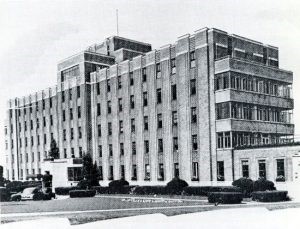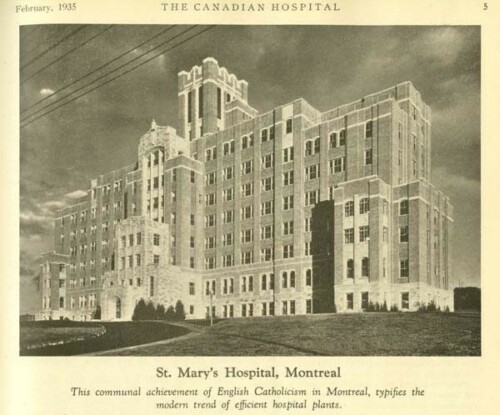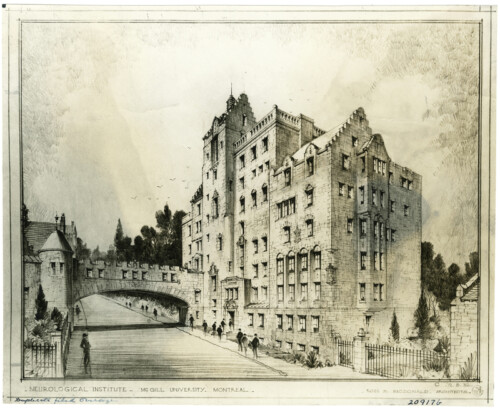Despite falling in the middle of the Depression, 1934 was a particularly auspicious year for health care in Montreal, with three English-language hospital openings in one year:the Jewish General Hospital, St. Mary’s Hospital, and the Montreal Neurological Institute.
Jewish General Hospital

The Jewish General Hospital (JGH) opened in 1934 with money raised by the Jewish community. Large numbers of Jewish immigrants arrived in Montreal in the late 19th and early 20th centuries, fleeing religious persecution, mostly in Europe. However, in Montreal they continued to face discrimination accessing care and, in the case of health professionals, getting hired in hospitals.
In 1912, Canada’s first Jewish clinic, the Herzl Dispensary, opened ; the Hebrew Maternity Hospital followed in 1916. By the 1920s, the need for a larger facility to treat Montreal’s Jewish population became apparent, and a large fundraising campaign was launched. The JGH’s founders insisted, however, the new hospital would treat patients of all faiths and languages.
Originally a small community hospital, the JGH underwent several expansions and additions over the decades, including Canada’s only Jewish nursing school (which closed when the CEGEP system took over nursing training in 1972), as well as the Lady Davis Institute for medical research and the Segal Cancer Centre. In 1974 the Herzl Dispensary merged with the JGH and is now known as the Goldman Herzl Family Practice Centre. McGill medical students began doing clerkships at the JGH in 1939 and the hospital’s full affiliation with McGill was granted in 1969.
St. Mary’s Hospital

Irish immigrants poured into Montreal from the mid-19th century, fleeing the devastating famine, and continued to arrive into the early 20th century. Mostly Catholics, these newcomers often had to choose between receiving medical care in English from Protestant institutions, like the Montreal General Hospital, or in French from Catholic institutions, like Hôtel-Dieu. A temporary hospital, St. Patrick’s, was set up to treat passengers from the disease-ridden “fever ships” that brought them from Ireland in the 1850s, but closed after 10 years; two specially-created Irish wards at Hôtel-Dieu did their best to treat Irish Catholics in English until St. Mary’s Hospital was founded in 1924.
The new English Catholic hospital was temporarily housed in a former mansion, Shaughnessy House (now part of the Canadian Centre for Architecture) on Dorchester Street (now René-Lévesque). It moved into its purpose-built present location in 1934 in Côte-des-Neiges, which was built with funds raised by the city’s Irish Catholic community and run largely by the Grey Nuns. Like the JGH, St. Mary’s founders insisted the hospital would serve all Montrealers of any faith or language.
In 1943, the Sisters of Providence of St. Vincent de Paul took over nursing services and the hospital’s nursing school, until 1972 when the CEGEP system was introduced and took over RN training. Although McGill medical students and residents had been training at St. Mary’s Hospital Center, as it is now known, for decades, the hospital only became officially affiliated with the university in 2013.
Montreal Neurological Institute

The Montreal Neurological Institute also opened in 1934. Unlike the other two hospitals, The Neuro was established for mainly scientific and medical reasons, rather than cultural ones.
It was funded differently from the JGH and St. Mary’s too: money for the hospital came largely from the Rockefeller Foundation, which had previously funded the construction of the Pathological Institute (now the Lyman Duff Building), also on University Avenue next to the former Royal Victoria Hospital. “A promising superstar neurosurgeon Wilder Penfield had a concept to bring together scientists and clinicians around neurological diseases and he convinced the Rockefeller Foundation to fund it in the middle of the Depression,” recounts former Dean of Medicine and McGill medical historian Dr. Richard Cruess.
Also unlike the other hospitals, The Neuro – now officially called the Montreal Neurological Institute-Hospital – was a McGill affiliate from its inception. That’s because the head of the Royal Vic and Dr. Penfield’s boss Sir Charles Meredith felt it was too big a financial risk for the Vic to take on at the time and so it was built under the direct auspices of the university, and so it remains today.
Related:
